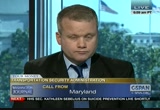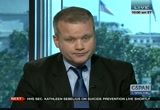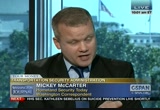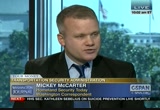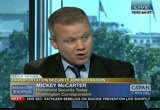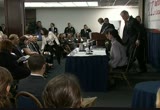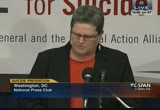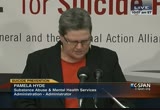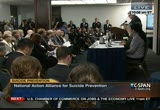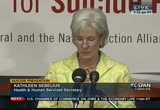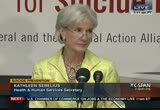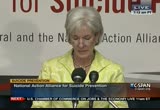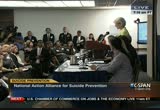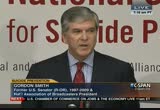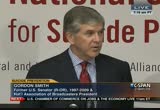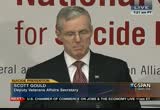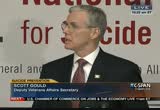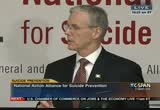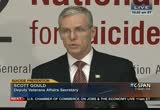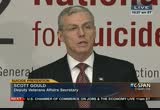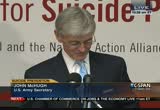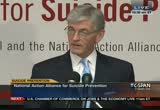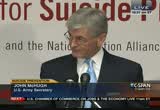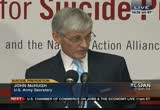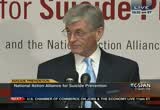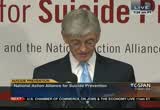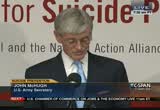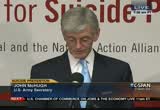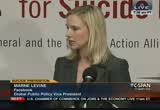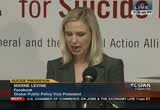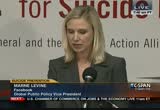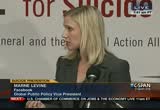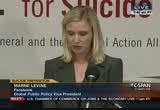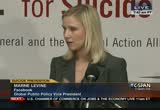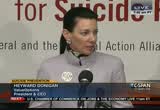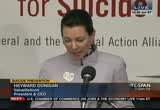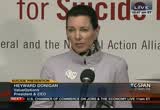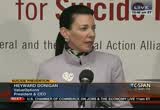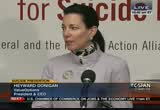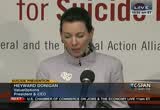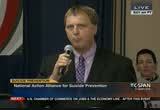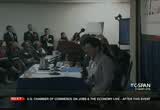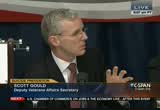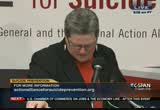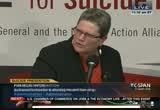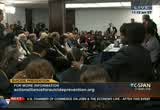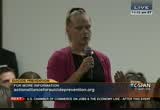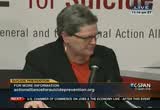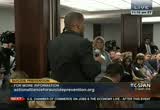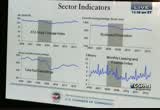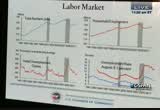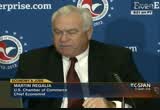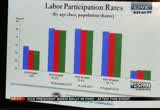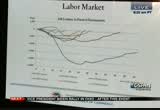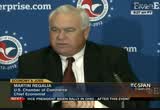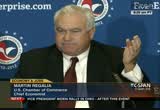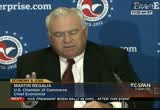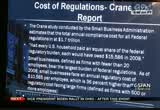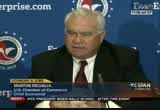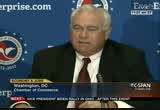tv Politics Public Policy Today CSPAN September 10, 2012 10:00am-12:00pm EDT
10:00 am
to it will renowned as security consultants, they say that the majority of the security measures are not needed, that is mostly theater. and there are big issues with the revolving door, the high level executives who have moved to private companies and have used their contacts to make money by scanners and things like that. guest: i read that newsletter myself and security theater is a tsa. that is often from at ps a. this t.s. sensitive to this and they try to react and be more affected. we will see if they can do something with the new ideas they have.
10:01 am
host: let's hear from vienna, va., independent line, good morning. caller: some of the body scanners are sitting idle while others are used to the maximum. we recently left dulles airport on a busy day and as far as i could tell, every single passenger was invited to walk through it body scanner. it was hundreds of people and i think that it's interesting. maybe we could do something to have more of a sample approach. guest: again, they are trying to work harder and they will put a focus on airports like dulles airport, a big airports, that have a lot of travelers going for too many different destinations so it does not
10:02 am
surprise me that you made that observation. host: tells more about the pre- check program guest: it depends on the airlines. they have gone to certain airlines and have said that your system with your technology, if you're computers can talk to our computers, we want to know if you have your frequent fliers and we want the intimation you have on them and to pick up in to participate, they can be part of pre-check. they fill out some forms and pre register and volunteer information. in return for that, there is supposed to be lighter screening process. tsa emphasizes that letter screening process. and the intelligence is that they need to do more of that.
10:03 am
certain things like not having to remove your shoes or your belt or maybe going not -- not going for the whole body scan, separate lines so you get through faster, those are supposed to be the benefits of being a member. host: is there any concern about becoming an elitist program? guest: the concern so for have been toward the other way. they're worried if a terrorist can manipulate this. on both sides of the spectrum, tsa says this is the point -- we're supposed to know something about these people's travel habits. if they are first-time flyer, they would look up their troubled history before you can
10:04 am
get there early into the program. host: knoxville, tenn. -- democrat. . caller: we are a family of 12 and we refuse to fly until the body scanners go away. how do you know these people are not perverts? the last time we traveled, we spent almost $23,000 per year which we don't do any more. guest: there are some outrageous cases where young children have been inappropriately patted down and people with medical devices have had their medical devices damaged or lost. tsa has apologized for those cases. host: here is a tweed --
10:05 am
is there a pressure on the tsa to get people through security in an efficient way? guest: i don't think they are doing it too quickly and i don't think there is pressure. they have not been afraid to discontinue screening in florida or hawaii. host: thanks so much for joining us today. that's all for us this morning and thank you for joining us. cspan goes to the national action suicide prevention. the guests include the secretary of the department of health and human services, kathleen sibelius' as well as the president of the national association of broadcasters and a former u.s. senator and others. [captioning performed by national captioning institute] [captions copyright national cable satellite corp. 2012]
10:06 am
>> good morning and welcome. thank you for being here. i am pamela hyde, the administrator of the substance abuse and mental health administration or samsa. each year, 11 million americans consider taking their own lives and about 37,000 died from suicide in 2009. almost 2.5 million americans over the age of 14 are distressed enough to actually attempt this. america loses approximately 100 people every 24 hours, not to the battle of war or acts of terrorism, not to natural disasters but to the incredibly shattering act of suicide. the told a suicide takes on american communities and
10:07 am
families is profound. keeping our nation's young people, elders, working age adults, and military personnel and their families safe from lost hope is as critical a public health issue as keeping them say from bad drinking water, tainted food, or infectious disease. samsa works toward creating a nation of communities free of substance abuse and mental illness. suicide prevention is a priority for us and mental health problems and substance abuse issues are leading risk factors of suicide attempts and completions. the suicide rate of persons with major depression is eight times that of the general population. over 1/3 of individuals who died by suicide of a blood alcohol level over the legal limit. samsa has a lead role to find solutions for these health issues but across our
10:08 am
initiatives and through our collaborative efforts and among our partnerships, many have been key players but three step want to call out -- richard mckeaon, marybeth and jim galloway help to develop the report you here today. kathleen sibelius and our surgeon general have been instrumental in this. they are tremendous partners in the urgent task of preventing suicide. the centers for medicare and medicaid services have stepped up to provide screenings and quality measures, in ovation awards, training, and soon to be informational material to help people with behavioral issues receive the help they need. we're joined today by these individuals and by numerous other federal and state agencies and departments, some of which
10:09 am
you will hear from today as well as by a tremendous private sector leaders on health, education, business, philanthropy, and advocacy. i want to thank you all for being here. we are joined in our efforts by survivors, people who have attempted suicide, lived to regain hope and recovery and families of those who have attempted or died from this significant help -- public health issue. they are the reasons we are here today. today we acknowledge the commemoration of the 10th world suicide prevention day and would begin day two of national suicide prevention week. we're also a little over a week into national recovery month. we raise public an awareness across the country that people can and do recover from substance abuse and mental illness. addressing public health issues such as these, meeting them head on and finding lasting solutions is something my boss
10:10 am
is well known for. secretaries of bilious has been a leader on health issues for more than 20 years and now she is leading us to a profound transformation of american health care system, focusing on prevention, quality, and the highest value health care possible for all americans. she is up to the test to make the most of every opportunity created by the affordable care act, ensuring parity for those with behavioral health issues along the way. it is my great pleasure and honor to introduce to you today, secretary kathleen sibelius. [applause] for thatyou, pam, nice introduction but more important, i want to thank you for the incredible leadership at this historic moment. i want to thank all of you for joining us at this important event and our partners at the table who you will hear from.
10:11 am
this strategy would not have been possible without the important partnership of many leaders here today from inside and outside government. i want to join pam in acknowledging a few people. the surgeon general, the director of the suicide prevention center. former senator gordon smith and secretary of the permit john mchugh for their tremendous work at the national action alliance for suicide prevention and all the private-sector leaders here today including the ceo of bell you options and marnie levine from facebook. two great health leaders and our department, pam hyde and b jonathan blum have contributed
10:12 am
so much to this important work. we are here today because we all have a role to play in preventing our friends, family members, colleagues, and neighbors from reaching the point where they think there is no hope and they take their own lives. that work has never been more critical than it is today. in the 1990's, we sell a slow but steady decline and the number of americans lost to suicide. since then, suicide rates have begun to rise again. today, suicide is the third leading cause of death for young people ages 15-24. we have seen especially alarming trends in our armed forces. just this july, the army lost 38 soldiers to suicide, an all-time one-month high. these are heartbreaking because they are preventable. that is why two years ago today, defense secretary robert
10:13 am
gates and i launched the national action alliance for suicide prevention. under the leadership of senator smith and secretary mchuggh, the lines brought together advocates from private and philanthropic sectors, health care providers, public officials, business and faith leaders and other federal departments and the armed forces. together kobe help shape a new strategy for suicide prevention that acknowledges the specific roles each part of the community can play in preventing suicide. we tried to identify the areas where collaboration can actually make the biggest difference. already, the action alliance has galvanized over 200 leaders in the pro -- public and private sector to join forces and do their part in fulfilling the alliance goal of a nation free from the tragic experience of suicide. as private partners step up to
10:14 am
the plate, our department also is committed to doing our part. today i am proud to announce nearly $56 million in new grants to support the national strategy. as part of the ^ lee smith immoral act, named for senators met's son garrett, these grants will help expand suicide prevention efforts. our department continues to support the national suicide prevention lifeline and to partner with the va on the crisis line. these call in line to allow people all over the united states and some overseas locations to call at any time, day or night, and get help and they need it. finally, we want to make sure that suicide prevention is part of our broader efforts to improve health care across america. for example, a couple of weeks ago, the centers for medicare and medicaid services announced new standards that doctors will have to meet to earn certain
10:15 am
incentive payments. we made sure that providing people who have major depression with suicide risk assessment was included as one of those standards. beginning last year, medicare also began covering an annual preventive screened for depression which is especially important since older americans have the highest rate of death by suicide. in the past, we have often treated mental health or substance abuse as personal issues. individuals must overcome these on their own or with their family and health care provider. by addressing these conditions, and recognizing they are just as important to our country as addressing any help issue whether it is childhood obesity, hypertension, or hiv aids and just like those public health issues, we must take action against suicide together as a community.
10:16 am
that is why this strategy contains information about how each of us can actually make. a make it starts with reducing prejudice against and the misunderstandings around mental health issues. it also means having the courage to ask important questions to anyone showing signs of distress. are you thinking of heard yourself? that simple act and start a conversation that can actually save lives. we have a long way to go to achieve our ultimate goal of a nation free of the tragic experience of suicide but thanks to a focused strategy and all the partners who have committed to implementing it, we have a clear road map for getting there. now i would like to invite to the podium, the former senator gordon smith. the senator and family have been personally touched by the tragedy of suicide. many people have turned away,
10:17 am
but he has decided to actually use their tragedy as a way to inform and involve a major other families are not touched by the tragedy. since garrett died, he has been one of our greatest leaders in and out of congress in trying to prevent the tragedy happening to other families. i am pleased to welcome to the podium, senator gordon smith. [applause] >> thank you madam secretary for your very thghtful words. thank many people but i would rather focus on the substance of what want to say. i must thank secretary mchugh. he was my college -- my colleagues in congress and he is the public sector leader of suicide prevention. he is more than an equal partner. he has a huge task.
10:18 am
there are others i should be thanking but i don't have time to name new but thank you. it was nine years ago plus two days that my wife sharon and i receive the news of my son's suicide despite the overwhelming sense of grief and the endless flow of tears, i saw something quite remarkable in the united states senate. it was so remarkable that it even made its way across to the house of representatives. we found an issue, the issue of mental health and suicide prevention, that does not have a partisan affiliation. it is an issue that registers with humans and not republican or democrat. what we saw with the passing of the garrett lee smith memorial act is americans united trying
10:19 am
to help what is an entirely preventable medical tragedy and that is suicide. today, we are re-launching a national strategy for suicide prevention. so much good work has gone into this from so many organizations which before or light blue sense of their rope that had frayed. they are tied together now in this strategy. our goal is that in the next five years, we will save 20,000 human lives. through all these efforts, we can easily calculate $1.5 million of time and contributions from private individuals and public individuals. we have also been funded by the federal government. we recognize that the budgetary situation of the federal government will put great
10:20 am
pressure on their ability to continue to help us so i call upon individuals, philanthropist, and corporations who care about this issue and you should care about this issue because this issue touches virtually every family, certainly every neighborhood and every community in our great nation. it is something we can do something about the worth of souls is great. join us in this goal. it is the work of angels. i thank you for your time and i'm very pleased to turn the podium over to scott gould, the secretary of affairs. [applause] >> thank you for that kind introduction and for all of your work and leadership in this area. i know it comes from the heart.
10:21 am
the veterans administration has been an active partner in developing the national strategy for suicide prevention. over the past four years, we have been grateful for the president's strong and decisive leadership for veterans and particularly for his support to improve mental health and reduce suicide. we're fortunate to have over 20,000 mental health professionals working at va. our budget has grown by over 40% in the past four years and we believe we are providing innovative and leading edge care in more than 900 locations across the united states. last week, president obama issued his historic executive order to further improve mental health services for veterans, service members, and the military families. it includes a hiring initiative of an additional 1600 mental
10:22 am
health professionals, a 50% increase in the individuals who man the crisis lines 24/7 and a new campaign call "stand by the empirical our effort focus on m." we know that va care and the crisis line networks. our system is the best in the country. six -- since its inception, one element of that care system called the veterans crisis line has received more than 655,000 calls. we have made over 93,000 referrals for care and we have rescued nearly 23,000 callers from potential suicide. history shows that the cost of
10:23 am
war will continue to rise in the coming decade. increasing the need to provide more mental health care that our veterans have current and they clearly deserve. we have learned from that experience that we still missed many opportunities to prevent suicide if only we had someone in care earlier in the process. time and again, after a suicide, family members, co-workers, friends knew that something was not right or that the veteran was having difficulties but they did not recognize the warning signs or they did not act on them or they were unable to convince that individual to seek help. let me give you an example of when this process works right -- a the veterans crisis line got a call recently from a veteran to mother who was several states away from her son and she knew something was wrong.
10:24 am
it might have been mother's intuition. he was a post-9/11 veteran who had trouble adjusting to civilian life and she could not reach him. she had reached out to his girlfriend who had recently broken up with him. she had received an e-mail that were read part that he was considering killing himself. she wanted to travel. she thought she got in a car, she will not get there in time. she did something we want you to consider doing here today. she picked up the phone, called the veterans crisis line as a family member and said, "my son needs help." @ cravaack spinelli trained individuals use their network to -- that group of trained individuals use their network to get to him. today, he is alive. he is engaged in care at a va
10:25 am
and involved as a coordinator at his va medical center. we need to help people recognize that something is wrong and know what to do with that in sight. there are thousands of success stories like this made possible by the veterans crisis plan and va system of care but we have much work to do. we have learned and that it will take all of us. it will take folks and vqa, dod, the community health providers, the family and friends and the employers and co-workers and neighbors of faith based organizations and veteran volunteers to make a difference for service members and veterans transitioning back into their communities. you can help. recognizing the warning signs that someone is having trouble and knowing where to turn to help will save lives. today, va is releasing a new
10:26 am
public service announcement call "side by side" focused on the important role of family, friends, and community have been supporting veterans who may be in crisis. let's take a moment together to take a look at that video. [video clip] >> we used to get together every week. she has been home from her last appointment for months now and i have not seen her once. >> he has been different since he got back from iraq. one minute he is ready to go and the next to does not want anyone around >> the nightmares are back and seem to be getting worse. shouldn't he be sleeping better after all these years to >> a lot of people don't understand what veterans go through during service when they come back, that's ok. not everyone can help. >> you stood by us when we were in uniform.
10:27 am
stand by us now. >> my brother would not take no for an answer. >> like my wife did 20 s three question >> like my friend when she needed the help. >> stand by them, they stood by you. visit veterans crisis long.net. >> there you go ,the va is here to help veterans and family and friends to reach out to the people we love and treasurer and we urging everyone here today, community-based organizations, veterans service organizations, health care providers, private companies, and other government agencies to connect veterans to our veterans crisis line. here are the numbers -- i thought i would never live to see if they were i look into a tv camera and say you need to call this telephone number if you see or know someone who is in crisis 1 ---800-273-8255 and a press1
10:28 am
or you can join us online at veterans crisis line.net or by text message and 838255. working together, leveraging our reinforces, we can stand side- by-side to prevent suicide. as a matter of hope and care adult community action. it is a privilege va to be part of this national alliance to combat suicide in america and it is now my great honor to introduce the secretary of the armed ,john mchugh and the public-sector co-chair of the action alliance. [applause] >> thank you. thank you very much. please extend on all our behalf our words of appreciation to secretary shinsecki.
10:29 am
i know secretary panetta would want me to express our deepest profession -- rather our deepest gratitude for our cooperation. 98% of the people in this room are doing -- are due a great deal of thanks. i will say that on a personal level in the hours ahead. i want to particularly thank my co-chair and partner and my former colleague and my good friend, gordon smith. as you have heard, sometimes the statistics, of this weighty issue, can stand large before you. it is always helpful to remember the human element. looking at senator gordon smith, understanding his family,
10:30 am
brings it all rushing home. we'll strive to have a small part of passion that he has shown in trying to make a difference to this thing. it is a terrific honor for me to have the opportunity to work beside him. to all the good folks at this table, particularly secretary kathleen sibelius' along with secretary gates helped us put this on a path to success ms. donegan and ms. levine, thank you so much for what you are doing. i remember very clearly just a few years ago, two short years ago, secretary sibelius and secretary gates launched with this effort. i don't know that all of us believed we could come this far in a relatively short 24 months but here we are we are
10:31 am
announcing the completion of one of the most important goals that was outlined in that seminal day in this very building two years ago. it is the updating of a national strategy for suicide prevention. i want to underscore the importance of this effort. think how far we have come since the last time in nationalists -- strategy for suicide prevention was put forth. oday we're joined m byarnie living from facebook. in 2001, when that strategy was last offered, someone asked about facebook and i started looking for a photo album. today, not so much. we truly have seen so much difference in this world and so many things changing. perhaps the most difficult change, the most change came in
10:32 am
that short period time since 2001 and that is also people we have seen, loss of promised they. head since that year, more than 356,000 americans, 356,000, have died but their own hands. to put that into perspective, that as more people than live in the great city of new orleans. despite all our efforts, all our best efforts, 100 more americans will likely take their lives this very day. one of them is likely to be a soldier. one reason i am proud to serve as the co-chair of this alliance is the fact that also have a high honor of serving as the secretary of the army. in the army, we consider ourselves an institution that makes every effort to instill and its members something that
10:33 am
to us is very important, something we call the order itos. it is a code of soldiers live by. it teaches them never to accept defeat, never to quit, and most importantly, never leave a fallen comrade behind. at this time, right now, today, we are losing more of our soldiers to suicide then we are to combat. in a real way, we feel somehow we have left those fallen comrades behind. it is easy to assume in the military at or that it is the things that's around, but, the repeated stresses of deployment and the time you are with her family and the perils of conflict. those are not the sole reasons why those lives are lost. like so many other suicide contradictions, the reality is far more complicated. in fact, the department of
10:34 am
defense completed a three-year study that shows that 54% of those in our ranks in the military who committed suicide in 2010 and 59% of those who attempted suicide in that same year never once deployed. 89% of those people never saw combat. what that tells us clearly is that we are dealing with broader societal issues. there is substance abuse, financial distress, relationship problems -- the order -- these are the risks for suicide in broader society. the army has dedicated a great deal of resources and effort into our own studies on suicide prevention, intervention
10:35 am
programs. you heard secretary gould note the partnership between military and dod. we think all the people of this nation will benefit. this type of continued collection -- collaboration of public and private sectors from all walks of life, this is where we see the real benefit. as suicide knows no, race, age, gender or economic status, a successful prevention and intervention efforts have to cut across the entire fabric of our society. that is why it we'dd in aod and me personally have been so thankful to be a small part in this process. more importantly, to see the great achievement that we are unveiling here today.
10:36 am
this national suicide prevention strategy will help each and everyone of us, help us to work better together, advancing goals and objectives to help alleviate the most preventable of mankind's afflictions. nothing is more fundamental to our success than communication, reaching out to those in need of guidance or support, especially the socially isolated. , listening to anyone in a friend or mentor and changing the public conversation on suicide intervention and prevention. improving communication efforts me recognizing that how we communicate, how we reach out, how we intervene has changed, the vault, and improve. by utilizing the communication tools, keeping pace with emerging technologies and creating innovative interactive programs will not only more effectively and immediately help those in need but also involve
10:37 am
more people in communities in reaching our goals. there is no question that one of the leaders in that effort has been facebook which is why we and i did, in particular, and pleased to introduce our next speaker, the facebook vice- president for global policy, marnie levine. [applause] >> thank you for that introduction. thank you to everyone here for your leadership and work on this important subject. every day on facebook, people share millions of georgia's. moments we see celebrations, reunions, anniversaries, and engagements. we see an infant's first set, a happy day at the beach, traveling to replace for the first time and sharing that with
10:38 am
somebody. these are the happy moments of life. these are the ones we really want to share and c. life, unfortunately, is not always filled with happy moments. the information that people share and social networks is not always just about being happy. sometimes people turn to social networks in their most vulnerable moments. sometimes, social networks are in place where people express their deepest insecurities, disappointments, feelings of loneliness, or despair or even worse. this is a simple truth and a time more social networks have become a reflection of the fullness of our society. they do not just reflect the happiness and. joy the refect -- they reflect the full complexity of life. since facebook is the place where people live on line today, it is not just an opportunity for company.
10:39 am
means we have a special responsibility to our users. we need to provide not just the tools and features and environment for those who come to facebook to enjoy moments of celebration but we need to be there at our best in times of crisis. that is why i am honored to be here today, participating in there-launch of the national strategy for suicide prevention. inre happy to collaborate this difficult time. the national strategy will help ensure that the latest research and technology will be put to full use to better support those in distress. those twin objectives -- utilizing research and utilizing technology -- mirrored the affected we take at facebook. when we began to be confronted with reports of suicidal content on the site, we realized we needed to do two things -- we need to engage in with the
10:40 am
community to respond to these situations and we need to use the power of facebook itself to mobilize friends and counselors to communicate and intervened with the person at risk. at facebook, nothing is more important to us than the safety of our users. we hope that by harnessing the power of social network and the crisis support from our suicide prevention partners, we can prevent suicide across our community. as a pro partner of the national action alliance in the past few years, we have established strong relationships that have helped us and others in handling these difficult situations. the alliance has shown that partnerships can offer the best place, the best help, where it is needed most. our longstanding relationship with the national suicide prevention lifeline has enabled us to provide intervention assistance to people in distress. last december, we were proud to
10:41 am
launch the latest feature with lifeline -- leveraging private sessions with counselors. when a facebook user is identified by friends as being in distress, that person will receive a personalized message from facebook containing a link to begin a confidential chat session with a professional crisis worker at lifeline. this important tool brings instant intervention counseling to those who need it when they needed. during the first week of the program, a teenage girl who was contacted told a counselor that you have no idea how many lives this could say. we also developed another feature on facebook which enables people in distress to use our report function to get support from a trusted ally. if you look at the facebook site, we have links on each and every page. by clicking on the report of link, you can message to your
10:42 am
friends, a parent, or co-worker or some other trusted figure in your social network. alternatively, you can report the content directly to facebook which is then reviewed by our safety team. by helping people connect to the community of support, we hope to be able to enable people to get the help when they needed. facebook is taking additional steps to prevent suicide. while there is no community that is immune to the tragedy of suicide, there are some at risk communities that face unique challenges and have proven susceptible. we have developed special target programs to support communities that are particularly vulnerable like the network of support programs l forgbt. we leverage the resources provided by other leading organizations l ourgbt users. we recently partner with several organizations dedicated to
10:43 am
military service members like veterans and families. time and time again, we hear from this community about how they are using facebook to stay connected. a recent survey of more than 2.2 million military families shows that over 85% of these families use facebook daily. to help protect these families, we launched a resource center for veterans, active-duty members, and military families in partnership with the department of veterans affairs. there's a crisis line which provides specialized support from counselors over the phone or on the web. we are working to create tools on facebook that connect to other mechanisms that goes beyond the web and that is something we want to keep doing and developing with the help of all of you. every suicide is a tragedy. though we may not be able to prevent the present one of them, we want to be able to do
10:44 am
everything we can to at least try. in collaboration with others, we can ensure that when people visit facebook, that have access to the resources that will help them feel more connected and receive greater support. through technology, our ability to communicate over vast differences and distances is nearly limitless and with the ability to share and connected friends on facebook, social networks may represent a unique opportunity to quickly reach anyone at risk or who are already in distress. it will enable people to speak up and take actio as soon as they see signs of a friend or family member in distress, i think we can make a real difference. we are very excited to be part of this announcement today and are looking forward to our continued partnership with the alliance and other organizations. i would like to introduce our next speaker, heyward donegan,
10:45 am
president and leader of options. she produced a video that is on the action alliance website. [applause] >> good morning, i guess. thanks to all of you and especially those up here with me. this is a very august group. to is a privilege to be part of this great launch in this great program. value options is a health improvement company. we specialize in helping 32 million americans achieve emotional and mental well-being. and recovery. it is difficult to find anybody today that is not impacted in
10:46 am
some way by mental illness and suicide -- or suicide. like the senator, i, too, have been impacted by this personally. i have a sister who suffers from severe depression and has struggled on and off over the years with suicidal thoughts and several attempts. we have been very fortunate that we have had the ability to learn how to handle this in a way that has caused us to help my sister prevent suicide several times over the last few years. if you've ever been through this, it is a desperate feeling, desperate times. my parents have had a troubled times with this but with great support and with a lot of help from professionals and friends and therapists and now my own colleagues at work, we have been
10:47 am
able to achieve some great success with my sister in the sense that she now has a built- in resilience and i have learned it resiliency is so important. she has been able to recover living with mental skills and suicidal thoughts. this is very personal to me. i joined value options two years ago and because of that, it is not just a profession, it is a mission. i understand firsthand the scope of mental thomas and the threat that suicide poses to so many with mental illness, my sister being one. it is not always tied to mental illness, that is a big factor. we serve a broad diversity of the population -- we serve the military and are proud to do so and are close to everything you all talked about today -- we also serve the lower income of
10:48 am
medicaid recipients at large fortune 500 corporations. everything from a suicidal sole to a depressed corporate executive to a low income schizophrenic or the populations research. today my focus is to talk about corporations. what we are focusing on corporate america's how to leverage the power of the workplace to create a culture of well-being. many of us -- i talked to some of you this morning -- are engaging in a culture of health. that is hugely important because of the obesity act -- epidemic and other things. we believe it is not just physical health but rather emotional well-being that needs to be addressed in the corporate workplace. i would argue that without the emotional well-being, you cannot have physical well-being.
10:49 am
many of the issues around obesity are around behavior and depression and food is comfort, for example. we are very focused on developing the workplace as a culture of well-being and add value options, we are personally engaging in this for our own employees. we hope the workplace will be a place where help seeking behavior in d thise-stigmatized and encourage. i think this will be a difficult process because the corporate environment is so much about productivity and so much about getting it done that to allow people to become vulnerable in this way will be a challenge. we had thought you options provide programs to employees and their family members so that they can reach out and get the
10:50 am
help they need. unfortunately, most people who attempt suicide to not reach out to the resources that are available to them. it may be that all the great resources that the army and veterans administration provide or that facebook provides a -- we add value options, are one of the largest employee assistance programs in the united states. , may be in the world. it is a very under-utilized program. no matter how hard we try to market it as a great resource, many people do not take advantage of it. it may be because it is viewed as mental health help. it has a stigma. employees are afraid that if they reach out, what of their colleagues finds out. even worse, what their boss finds out?
10:51 am
that is true of our company even though we are such advocates for mental health and well-being. this is where the corporate culture that walks the talk on health-seeking behavior can make a difference. it has to start of. at the top i have learned this in my role. that's what i tell my story to my employees. it has to start with the top, that it is ok because i believe that you all need to seek whatever help you need to be able to seek help with your mental and well being and do whatever you can to prevent suicide and it can make a difference. we have designed a comprehensive tool kit to assist business leaders to customize and implement effective suicide prevention programs. we make a wide our rate of resources directly to our
10:52 am
employees and their family members and our clients' employees and their family members. especially advocating for individuals to know when and how to seek help. this is available as well in the general public and available to the general public. we are really attempting first and foremost to de-stigmatize mental illness. with that will come the kind of help-seeking behavior we need to help those contemplating suicide. mental illness affects one in four americans. that is twice the rate of breast cancer and yet you don't see anyone walking around with a black plastic band around her arms, advocating for walking for effective mental illness treatment. d have toe-stigmatize it -- we have to de-stigmatizes and that
10:53 am
will be critical to better our chances in the fight against suicide. i am proud to represent value options today and proud for the action alliance and a national strategy on suicide prevention. with that, it is my great pleasure to introduce to you, dr. regina benjamin, the 18th surgeon general of the united states. [applause] >> thank you. and thank you all for being here. preventing suicide is everyone's business. every day, nearly 100 americans die by suicide and in the past year, more than 8 million americans have thought about suicide. that does not include the 16% of high-school students. years ago, just as i was to take over as the first african- american and first woman
10:54 am
president of our society and alabama, i spoke on the phone with our executive director on friday evening. we were supposed to talk again on monday morning. after i did not hear from him, i started calling only to learn that on friday night, he went upstairs, went into the closet, and shot himself. to this day, i ask myself what i could have done, what should i have done? i am a doctor and i did not even know. today's suicide prevention strategy shows us how individuals and communities can come together to put the process together in place to help people like him. suicide is a tragedy of on told proportions and those of you who are part of that tragic story line know that language too well. 10 years ago, my predecessor,
10:55 am
released the first national strategy for suicide prevention. he began a new conversation about suicide in america, making people aware of the problem. since then, the suicide prevention committee has been telling anyone who would listen that more than 33,000 people take their lives in the united states every year. that is one person every 15 minutes. now it is time to turn our conversation to prevention. from the national perspective, we get the biggest advance in the field with the launch of the national action alliance of suicide prevention. this body was called for in 2001. it was launched by secretary kathleen sibelius and then secretary gates. part of this alliance, we have multiple groups and organizations trying to address the issue of suicide separately. this brought us all together.
10:56 am
several hundred people have been called in this huge effort to revive the 2001 strategy. we get broad input through virtual meetings at listening sessions and online opportunities and engaged others. we want to make sure that this national suicide prevention strategy alliance will with our overall national prevention strategy. that was released last year and called for in the affordable care act. for the next 5-10 years, this strategy would be our nation's strategy. this revised suicide prevention strategy captures the progress we have made, the knowledge we have acquired, the promise that is within our grasp that suicide is preventable. activity in the field of suicide prevention has grown dramatically since 2001.
10:57 am
government agencies have all labels, nonprofit organizations and businesses have helped start programs to address this. we have enacted the garrett lease met memorial act. 1 that is800-273-ta:l. talk/ we have increased training and community awareness programs. we have had major developments in research and practice such as an increased understanding of the link between suicide and other health issues like mental ailments and substance abuse, traumatic or violent behavior. we know that connecting us to family members, teachers, co- workers, community organizations and social institutions can help protect individuals from a wide range of health problems including suicide. we have new knowledge on groups
10:58 am
that are at increased risks. we now evidence of the effectiveness of suicide prevention, intervention like behavioral therapy and crisis lines. we recognize the value of comprehensive coordinated prevention efforts and providing new methods of treatment with follow-up. the national suicide prevention strategy is organized and they have their respective 13 goals. i will not list all of them. there are major themes that the national suicide prevention strategy has. we want public dialogue. we want to address the needs of vulnerable groups, to integrate public health and behavior helped to insure continuity of care we want system changes and systematic changes. we want access -- we want to
10:59 am
reduce access to lethal means of those at risk and we want you to talk about it. don't be afraid to ask. knowing the warning signs such as talking to somebody who wants to die, talking about wanting to or feeling like they are trapped -- they have talked about being in unbearable pain or being a burden on others, somebody who has been looking for a way to kill themselves or increase or decrease sleep or are withdrawing or isolated -- if you see these warning signs, don't leave the person alone the removing of checks that can be used, called a national suicide prevention hot line. it is the life line1-,800-273- talk. if all that fails, take them to the emergency room. working together, we can all
11:00 am
help. we need partnerships to achieve these goals. when a concerted effort of policymakers and health professionals and stable -- local government and insurers and community leaders and advocacy organizations, consumer groups, fate based communities and individuals. i would like to share some examples of individuals who help prevent suicide. david? >> as the executive director of the 12th largest retirement community in the united states, i do all the good i can to support the physical, emotional, social, and spiritual health needs of the older adults living at my community. you can imagine how disturbing when i arrived at a
11:01 am
methodist village in two dozen 5, and by that december, my campus had experienced its third death by suicide in just 14 months. i was particularly troubled that i had been visiting with the third resident just six hours before he took his own life. i had not recognized the signs. his death had a profound impact on me. today, the methodist village as a task force trained to increase awareness and promote emotional well-being. suicide prevention is a system wide effort there, one in which everyone plays an important part. i am pleased that since 2005, we have not had another suicide. everyone plays an important part
11:02 am
in suicide prevention. my role as executive director is to provide hope and health to seniors in a caring community. i'm david denton, and i'm delighted to be here to support the national strategy for suicide prevention. [applause] >> i am senior in high school in new york. for me, preventing suicide means helping my classmates to any feelings of anxiety. my classmates come to me when they have a problem. when classmate came with a problem she felt she could not handle alone. she was having trouble with other students. i connected her with a teacher she trusted, and the result things. we kept the student from
11:03 am
reaching a point of crisis by creating an open community. this helped change the culture of our school. everyone has a role in suicide prevention. my role is to show strength as a peer leader. i'm happy to be here as part of the national strategy for suicide prevention. >> what i am about to tell you will feel like an open wound, but it is very poor. i suffer from pds d i sustained while on active duty. i'm also a suicide survivors. after serving i became unemployed and homeless. during my search for resources, and support, veterans services work limited to be caught a single parent and a woman veteran. suicidal thoughts were a constant problem. one day those thoughts turn to
11:04 am
an attempt. it is difficult to say so, but it is true, i hesitated long enough to telephone a family friend dead if had not been for my friend talking me through, i would not be here today. that was more than 20 years ago. i have earned several academic degrees since that time, created social justice on facebook, and we help women save their own lives to giving them support and getting them to the resources they need. since then, help for those with suicidal thoughts as progress. everyone of you as a role. this new strategy is a tool that is accessible to everyone for suicide prevention. as result of my advocacy, i found my voice. as a result of someone who cared and who helped me when i was suicidal, i have found my own life.
11:05 am
my name is bridgett, and i support the 2012 national strategy for suicide prevention. thank you. >> thank each of you for sharing your stories. finally before we take questions, let me show you our brief public service announcement that is aimed at the general public. i hope you will use it to get this important message out. ♪ >> suicide touches the lives of many americans. most of us know someone who attempted suicide or has died from it. perhaps you have had thoughts of suicide. i need your help. please call the number on your screen so we can help prevent
11:06 am
suicide. [applause] >> thank you to ever been. we will take some questions. there are a couple of people who have to leave, but i want to get you an opportunity one more time. the national suicide prevention lifeline, and it is connected electronically to the veterans crisis line, so we want everybody to be aware of that. we will take questions from the press, and we would like to ask you to make sure you did not speak until you have a microphone in front of me. there are people walking around with microphones, and if he could state rene and affiliation before asking the question, and if we get done with the press, and there is the time, we will take a question or two from the rest of you. do we have questions? >> hi.
11:07 am
i am with reuters news. they never taken much question. you mentioned a 50% increase in telephone operators for the crisis . can you give us more detail on when that will start, and it's just you have been overwhelmed with calls. can you talk about that need. >> thank you. we have seen increased growth in the use of the crisis line, which is a good thing. it means the word is getting out, that individuals can reach out and get help from these expert operators. you may not know that we also provide the service for our dod colleagues as well, this and individuals, trent , level of care providing the services that the department of defense uses for the san crisis line. to your point about the growth in personnel, we have about 200
11:08 am
people who man the phones now around the clock. we are adding another 100 on top of that. hence, that 50% increase, and we believe it will fully meet the demand we're facing. this administration has a commitment to make sure if that is not enough, we will be hiring more. >> and for federal government that may not always collaborate, this is the best collaboration you could imagine. the number we have been pushing, is for anyone to call with a special connection for veterans and service members. all right, other questions from the press? over there. >> regarding the $56 million for the new program become what can you be specific what the world will be for primary care givers and hospitals? >> yes . those grants are a program which
11:09 am
are a combination of grants to states for statewide prevention efforts as well as two campuses, for campus-based efforts. those campuses -- those efforts range from suicide prevention activities and messaging to actual services for primary care and others who are trying to address those issues in each individual state in a different way. if there are particular state or areas that you are interested in, we can talk to you offline about those different grants. other questions from the press? actually, i might add that 56 minute dollars includes money for the national suicide prevention lifeline we have been talking about and for the prevention research center as well. it is a series of grants and resources. other press questions? >> i am from "clinical
11:10 am
psychiatry news." can you address what the role of physicians play, in helping to prevent suicide? >> all positions play a major role. one of the things we have done and we are calling for in this national suicide prevention strategy is the increase in clinical training, in access to clinicians to understand better, so we are targeting all positions. primary-care specialists, everyone. >> i also might say that the senate for medicaid and medicare services are involving -- that the centers for medicaid and medicare services are using screening tools for people who have depression, and additional screening poor people who screened for risk for suicide. there is also training they are
11:11 am
working on. some of the dollars we have been talking about for these efforts come from the affordable care act and prevention fund and that is there. there is a significant amount of work on the federal agencies and the private sector health care for primary care physicians hoping to do that major screening. we are amped interested in emergency rooms, understanding what they can do, so understand what people are any emergency room, getting follow-up care can be one of the most important things to say they life. >> those are not limited to clinicians, but also to their staff, because they are sometimes the first people who encountered a patient. >> other press comments? need a microphone? >> "congressional quarterly." you mentioned the use of existing affordable care funds.
11:12 am
will there be additional requests for preparations you see next year? the money's did not support efforts that we have announced here. veterans in the department of defense and others have dollars as well. this fiscal year 2014 is still in process, so we're not able to discuss that. this is a priority. >> in fiscal year 2013 we will spend $6.2 billion on mental- health care, specifically $73 million dedicated to suicide prevention. both numbers are available, and our 2014 numbers look like they will reflect the continued leadership and commitment from the president on this issue. >> other press questions? ok, c and no further hands, i
11:13 am
will take one or two questions from the audience. over here. >> good morning. i am the executive director of a support foundation. i am also an 11-year army wife, so it is great to see this collaboration. one of our concerns in the community is integrating families more effectively to suicide prevention efforts. some of the gaps in policy are making that difficult. i will mention two. as far as i know there is no policy to rest privacy concerns. we are directed to let our command know if our husband is having problems. nobody talks about what happens after that. there is also no policy to deal with the secondary trauma on the families. i have lost three friends' army
11:14 am
wives to suicide, and there's no operation in place to deal with that. it is not correct commanders how to deal with that. regulation that is very stringently defined and vaguely worded makes it difficult to collaborate at plower levels. understanding the v.a. and dod are trying to fill that need. they will never be able to fulfil all of the knee. in makes it a nickel for us to access or know some of these nonprofits, took asking the senate to ask the general counsel for an interpretive clarification memo to make it easier for these nonprofits to coordinate. >> one of the things the order called on was to increase the number appear supporters and workers, because we think families and peers can be
11:15 am
important supports. >> take you for standing up and identifying those issues. this is an incredibly complex set of interwoven policies that we need to resolve. the issue ofde-stigmatizing, and how to manage the relationship is the core of what you are concerned about. we're working with given hour, and they have been a wonderful resource. we have the national resource web site where we identify resources for folks, family members, service members, and veterans which they can use to seek help. >> one more question and then we will end. over here. >> i am a student at montgomery college. how much emphasis is being placed on the de-stig
11:16 am
matization, especially in the african-american communities, because many people will not talk about it. we accept it and let it go, only havsuffer, even as i myself a suffere . >> one of the things we are trying to do, whether suicide or other issues, is recognize there is prejudice and misunderstanding and lack of information associated with mental health and substance abuse conditions. we are trying to make it clear these are public health issues. we are doing that through our communication efforts, through efforts like this, that some of the people stand up and say this is a public health issue. it is a health issue. it is an act of courage to ask for help. and to help your college roommate, your friend or neighbor, or parent, or sun, to
11:17 am
get help. we're trying very hard in the number of ways to help that issue. we will take -- >> that is one of the major themes of the national suicide prevention strategy, is just that cannot take away that stigma, to make it ok to talk about it. in the past, we did not ask people are you thinking about killing yourself? we are free that it may give them an idea. we want you to change the way we think about suicide, to think about it as a public health issue. thank you. >> that you all for coming. we appreciate your support and we hope he will make a difference in this issue. thank you. [applause] >> we will go live to the u.s. chamber of commerce in washington for their yearly labor day briefing outlining
11:18 am
economic and jot issues for businesses. it began just a short time ago. >> give them the benefit of the doubt having inherited a very steep economic downturns and a downturn that came together with a financial crisis all of which is often repeated in the political ad. going forward we will not have that type of an economy. we will have one which has started very low and is gradually building. if they did not get their act together and fixed the long-run and deficit problems, they will be held responsible for what happens down the track. you can legitimately do that when we look at the economy's they are lot -- economies are likely to inherit. if you look at indicators that come from the different sectors, trucking, railroading, we mixed
11:19 am
up and put it in a box and put it on trains and ships at iraq. these indicators are good indicators of when and in term -- of when a downturn occurs. we do not see that in any of these. you do not see these turning down in a way you would expect given the onset of recession. the and the mentor -- fundamentally, the underlying economy is not signalling recession. you do not see much in a way of an uptick. all of which supports our contention that what we are looking at is a moribund, fairly pedestrian rate of growth in the economy, over the next couple years. not a recession, unless, of course, there is a major mistake in policy. on the trade side, things are pretty good, but you can not sell much abroad when the rest of the world is either in recession or flirting with recession, especially the rest of the world you sell to.
11:20 am
our biggest trading partner is in europe. we see slowdowns in china and india and the less developed areas of the world that would provide potential markets for us. it is not likely trade will be at part of the economic downturn. trade will be on hold until our dollar weakens a little bit. when we seem to be one of the strongest areas in the developed world, you will not see that currency to appreciate compared to the -- to depreciate. we would sell a lot more to europe if the price point shifted more in our favor. to get to the point in the discussion, the labor market, we are seeing an abysmal labor market. the numbers that cannot friday, were lost over at first.
11:21 am
some of that network's started to drill over them. it is harder to find something that is good. the overall number of jobs created or poultry. 96,000 is not enough to drive the rate down. what drove the rate down was over 360,000 people left the work force. these are people that are either getting discouraged or quitting because they are staying in school, opting out of the labor force. it is a voluntary popped out. these are not people but are pushed out. they are more discouraged over their prospects or are looking at because the labor trade-offs and saying now is not the time to put more effort into looking for a job. maybe i should go back to school get training, do something other than trying to find a job. that is really telling.
11:22 am
when you see drops in the rates that aren this chart, when it has picked up like a snowball going down hill, and nbc2 had a 60,000 people leaving the labor force, that is a telling statistics on the quality and quantity of the jobs that are out there. it is a member to watch. interesting that the elections, year seeing campaigning, that the elections were turned off as something as arcane as a participation rate. administration has said we will see less than 8% unemployment before the election, and others have said the unemployment rate will continue its current range or perhaps even rise. all of that will not depend on the overall economic growth, which is more blunt, or on the job growth, which is less than
11:23 am
stellar. 90,000, 100,000 a month average is not something to write home about. on the participation rate, if it keeps rising, the unemployment rate well continue to drop. looking at the duration of unemployment, and it is coming down, but if you look at the duration in median duration, we are 50% or above or below, and you look at the average, that is telling because the median is 19 weeks, and the average is close to 40 weeks. that means some of the people out there in the tail have been unemployed for a long period of time. when that happens, it becomes chronic. it is very difficult for these people to re-enter the work
11:24 am
force. they become discouraged, quit looking, retire early, and all of those things do not treat a vibrant economy. the duration coming down is a good thing, but the difference between the median and the average and seeing the average higher suggest there are chronically and fundamental long-term unemployed out there, and it will be hard to reach introduce them into the workforce into the productive part of society. i looked at the parsing of the participation rate, because there was a statement that said this is old people retiring. people who should be practicing their cast think instead of sitting around in the office. i tend to agree with that. that is probably a good thing to do. that is not what is causing the decline in the participation rate. it is not the 55 and older.
11:25 am
we're seeing a higher degree of participation with that. we were suggesting that older people were going to have to work longer, but these numbers suggest that argument has more ability than the one that says they are retiring early. what we're seeing is that 55 and older are participating at a slightly higher level, and that the drops and the participation rate are coming in all the younger cohorts, which is not suggested of a vibrant work force that is offering a lot of opportunity and attracting a lot of participation. when we look at some of the prior recessions, what we see is this economic downturn was very much steeper, longer live, but did not get the kind of staff back. we did not get a v-shaped recovery. we had a lack luster recovery, and this has been indicative of the last couple processions.
11:26 am
when we saw at the first couple times iran, which set there's something out there changing, it is symmetric, we get a modest recovery -- recession, a mild recession, and we get a mild recovery. this time around we had a steep recession, but we still the kind of slow, agonizingly slow growth coming out of it, and as a result we are far from getting back to where we should be. as you saw in the chart, in 1991 it took 19 months to get back to our prior peak in employment. usually we did that in the year. in 2001, it took 39 months, and that was the jobless recovery everybody worked back. this time around, we are 37
11:27 am
months into recovery and we are still 4.5 million away from the prior peak. if you do the math and you say on the household numbers which go in to create and calculate the unemployment rate, we're doing better than 100,000 a month, and we got about 120,000 a month on average on the household survey, and you have 100,000 new entrants, that makes you use 20,000 to eat up the depth increase in the en unemployment rate. how would you have to grow to get back to where we were? it is like four years or five years in the best of circumstances. at today's growth rates. you saw that gdp line paralleling the potential line. with the growth rate that slow and job creation as low as it is, it will take years to get
11:28 am
back to our prior figures. where two months away from the worst record job recovery in the postwar era. that would have been in 2001. we are years away from reaching that point in this economic recovery. that is telling, where we are in the labour force. if you look at other statistics, wage growth, depending on which measure you use, it has been slow or nonexistent. the use a typical real average hourly earnings at come off the peak. if you look at paper worker which looks at a more holistic view of compensation, look at real employee compensation, which includes benefits, and you see a little better performance, but very slow by historical standards. you look at the things like the
11:29 am
poverty level, the amount of the percentage living under the poverty level has increased dramatically. you would expect that during the downturn, but also to reverse quickly as you start up. we've been recovering now for over three years and we're seeing increases in the poverty level. it is over 15%. you play the political game, clinton had a year when the poverty level was up around 15%. we have now seen 15% breached again during the bush and the latter part of the clinton administration which did not occur. that has to do with the cyclical nation -- nature of the economy. in this town, everything is political. if you look at the genie coefficients, one is skewed. you want a lower number. it has been rising now for over
11:30 am
30 years. we are becoming more desperate in our income distribution, to republicans and democrats alike. if you look at the numbers come during the clinton administration, the coefficient rose more that during the bush administration. this was because when you start out in a recession, the coefficient tends to drop. recessions hurt the rich more, said the distribution flattened. during bubbles you'd see the distribution becoming more desperate, because wealth begets wealth. in this type of situation, you play the presidential administration game whereby you look at the year after they started and the year they got out, you actually find that jeannie coefficient rose more during clinton that underbrush. oes that mean one's politics
11:31 am
are better or worse than others? not necessarily. in the end they used to run the butter commercial, it is not nice to fool mother nature. a comet hit -- in the economy, it disposes. it determines that, and if you were to take a more holistic view over the longer term, you would see you get a better outcome than trying to play the political cycle game where one group comes in and it's one thing in and the next group boast that out and put something else in. that tends not to produce the kinds of policies that can be maintained over a longer period of time to generate benefits in the economy. when you have seen distribution becoming more desperate for 30 years, try to associate that with the politics or the political outcomes of a particular administration or congress to me seems like a fool's errand. it does not seem to connect.
11:32 am
one is occurring for 30 years, and policies are in and out over a much shorter cycle. you are not seen that type of beneficial movement. some would say you did not let this policies stand long enough. others would say you missed the policy. you can take your pick, but the two are not gelling. we have seen these phenomena occurring for a much longer period of time than a particular election cycle. when you look at the shares of the tax code, this is a charts that sends me up the tree when i hear the president talking about their taxes. -- fair taxes. when i hear fair, i think proportional, that everybody ought to pay according to their needs. you see the income distributions have not changed. they become slightly more disparate overtime over a very long period of time, but the poor have not gotten a lot poo
11:33 am
rer. the groups that have changed places is above the 1% in the next quarter down. you look at the taxes, you see the same things. the top 1% pace a much higher percentage of federal income tax and the next jump pays another large percentage. the people at the bottom cannot pay much at all. we have a progressive tax system that remains progressive. it is not fair. it is progressive. the rich paid more. you can debate whether they can pay much more or what about what to say it is not fair is something that is not borne out by the statistics. it is a progressive income tax. the top 1% controls something like 40% of income -- excuse me
11:34 am
-- 21% pace 39.6% of federal income tax. they pay almost twice of what the income percentage of what the control. you can ask why is there that degree of disparity in the income distribution. many of the studied it. -- many have studied it. in an economy that is becoming more technologically proficient, they are the returns to technological proficiencies and they tend to be greater. that would skew the disposition. the skill set you need is reporting more dramatically in this economy than in prior economies where there was a a manufacturing sector that had many more jobs that were repetitive jobs rather than more innovative jobs.
11:35 am
to try to take something in a chart that looks like this and goes back over 30 years or longer and attribute it -- i would defy anybody to sit down with the exception of the few major bumps -- if i did not put dates on the bottom there, for the different administrations, whatever, there would not be too many of you that could get close. this is an economic chart, not a political chart, and when you try to cross the two you stretch the truth quite a bit. finally, i would get fired if i did not mention the fiscal cliff. i started with this and i will get into quickly, because this is self-inflicted. this is where the political aspects of the ruts of the short term, what are we going to do
11:36 am
between now and december, will affect the economy. over the long run, will it change the income distribution? i do not think at all. in the short run, it will very much dominate the economic cycle. if we do not figure out a way to finesse this fiscal cliff, either pushed it on into the next year or so, while we can look at some of the more fundamental problems in a somewhat less heated environment, if we did not figure out how to kick this can down the road at least in the relatively short term, which almost certainly will be in a recession by the time we meet again at the end of next summer. this is something that just the fact it is hanging out there is depressing economic activity. it is one of the reasons with improvement in the housing market we're not seeing dramatic anticipated improvement in the economy. we have to address it. everyone knows they have to
11:37 am
address it. then you hear things from both sides. i watching our being saying maybe shui should go off the cliff. patty murray saying if the republicans do not do anything, we will take them off the cliff. i have a great deal of disagreement with all those statements. going off the cliff is not the preferred strategy. calling off the cliff will not make the world better for the people who are unemployed trying to get jobs. figuring out how to address the clip in the short run -- and this problem in the longer run -- is what we want the people in congress and in the administration to do. figure out a way to keep from going off the cliff, and then figure out a way to address the long-term fiscal problems of this economy and of this country. we spend too much money with the recession's we have had recently come out the tax take is down, we have to figure out a
11:38 am
way to balance the tax take with the spending and balance it in a long-term sense. if you grow at 2.2% a year as we have been doing for the last three years, and you have a cassette that is more than 2 per 2% of the economy, you are going to add to the debt levels. we have been running at levels that have been up to 10% of the economy while we have been growing at about 2%. what that has done is driven up the debt to gdp levels dramatically. that is an economic study, a number of them, that suggests an economy as diverse as ours can handle debt levels in the 70% without too much detrimental activity, maybe for a short time handle debt levels up to 100%, and if you look at our gross debt, it is a little over 100% now.
11:39 am
we cannot do that in perpetuity. if we want to get the debt levels down into the 60% level, where they were just a short four or five years ago, we will have to address the spending side, and that means entitlements, and we will have to address the revenue side, and that means what we're doing with our tax code. this is what congress has to do. they have to avoid the fiscal cliff and they have to make realistic strides towards addressing our spending and our revenues. it is not easy, but that is what they should be focused on. it is hard to see that that is what they are focused on in this environment. we're looking at an economy, 2%, the recession if we do not go off the fiscal cliff, but not much in the way of acceleration at least for the next year or longer. we're looking at a labor market that is truly draconian, one that has very low job growth,
11:40 am
barely enough to employ the new entrants, that is driving down the unemployment rate be only because people are leaving the work for others -- the workforce, and has no prospects in a long term. that is the goal, what we need to do, where we need to be. it is not what we see being focused on. we have had numerous that commissions that the not go anywhere. if at super committees and special committees and select committees and at hoc committees and gangs of six and a and 10 and 12 and everything else, and we have not made any real headway on this issue of the debt and deficit in the long run. but the way, we get through the fiscal cliff, figure out how to make some grand bargain to address the debt, we still have
11:41 am
a debt ceiling vote in february. >> i have a key slide. it might be a function of a fact that i have a ph.d. the "i dream of genie" slides. there have been a lot of debate on the presidential election. there is no question that -- no disagreement that wherever that debate goes it is employers and workers in this together and they build their businesses together. a lot of what labor day is, that is what it is, celebrating the contributions of workers. workers and employers are all part of the st. nick's there, building golf together. i have some slides here, simple,
11:42 am
with regard to but employers do on behalf of their employees. sometimes i think in this economy in particular, it is a picture employees on the short end of the stick. some are in some circumstances. if you look at the data, it is impressive and needs to be told. employers spent 7.9 $6 billion in compensation in 2010. wages and salaries account for six joint for -- for $6.40 trillion. compensation is ignored as a part of the packages that most employees years -- employees and drug. given what happened on capitol hill last year, this is prior to 2010, prior to "obamacare."
11:43 am
we have 170 million americans receiving their health care through their employers. this is what employers to voluntarily do to provide benefits. $560.9 billion for group health insurance. these facts are in your doubts, and this is the tip of the iceberg. paid leave, there's talk of the press about when we talk about expanding the family medical leave act, which we see in the states, and perhaps again on capitol hill, the reality is the vast majority of employers may not have formal paid leave policies for the family medical act, but have them for their employees. if you take that paid leave, vacation, sick leave, as you have to. the small employers, are they as
11:44 am
generous? no, they are not. is a quick snapshot of what is gone on that employers cannot get credit for. they know they have to keep employees happy because in the work force because they are building a product together. i will talk about regulations later, which is the next slide. these kinds of benefits, says the biggest problem for the union movement when it comes to labor day and they complain about why they're stuck at something like 7.6% of union addition rate in the private sector. for my friends down the street, at the afl-cio, employers are not that bad a guy. things are not the same said they were when upton sinclair wrote "the trouble."
11:45 am
-- "the jungle." they have to change their message and change their product. it continues to be a message they cannot seem to pick up on. if you look at -- that we talk about this in the context of right to work lots. sometimes the unions and others say if you support these laws, you must be anti-union. that may explain exactly what i right to work law is. all it does say is in no state you can and an exemption that says you can organize workers in a union, but you cannot threaten them with a loss of their jobs if they do not pay union dues. and right to work laws, many
11:46 am
people belong to a union, but you cannot say if you did not paid them dues, you cannot be fired. all the other panoply of protections under the national labor elections -- relations act, are all still there. what is the big deal? it is that unions and those kinds of cases have to convince workers they have a product that workers will support, that they should purchase. what is the big deal about that if in fact you have a service that workers should like? frankly, we do that every year at the chamber when we have to raise money. i wish we had a mandatory two system where we could tell our members to pay up or else, but we we do not preclude we renew our base and keeps us on our toes. if we had a federal right to work law, you would see people
11:47 am
the street on their toes trying to develop a product for their workers and maybe that would be a good thing. let me -- i will not deliver the fact that ian's continue to blame tell-all as to why -- that unions continue to blame the laws. in the clinton administration, the decline of union rates have continued. it is not the law. it is something they are selling, and they need to get their message if they want to turn around the rate. when you see things like the chicago teachers strike coming up, and the average employee making something like $70,000 a year and turning down a wage package of something like 16% over four years from rahm emanuel, i think there gets to be a perception problem with
11:48 am
regard to unions that they have to deal with. there's a potential strike coming up on the east coast, and if that comes up, the unions will have a problem, and they may be shutting down ports during christmas time, not a great puerto rico move, but you should read a report that came out of new york on the unions involved, and ancestress relationships -- incestuous relationships in the third- bedding. i will skip polling and good to regulations. lately, costs of regulations on employers have gone trivialized lately in some of the comments made at the conventions. regulations are a big deal to employers. a study came out and i will go
11:49 am
through this, which estimated the compliance costs at $1.70 trillion. that is a tax on households of $50,000 in 2008. why 2008? this is the most credible data available. a small business is defined as a firm of 20 or fewer employers. 36% higher than large firms. this is serious business we're talking about, and when people trivialize regulations, i want , r the purposes of a propm these are from the federal labor standards act. there is no exception for employers under osha.
11:50 am
this is what someone -- if you have 20 employees or more, you need to read through these and understand what their obligations are. there are thousands of pages of the federal register, 5000 covering labor. take a look. i'm not vanna white. this is one page, and this does not even count the number of pages that go with regulations that are in the preamble that if you are a lawyer you have to read and understand what the regulation is pack. -- is. people in washington, and i worked on capitol hill for 10 years, is track of what employers must base at the same time they're trying to run a business. this administration has tended to be emphasized this area, although they have recognized that maybe we can do a better job, but i want to put out the
11:51 am
come in with woefully low numbers. this is all in the analysis that is on the table. if you have not picked it up, i hope you do. i will not go through it, but they have ignored the fact that we already have a base of burdens on employers already that employers have to comply with, and they assumed there is zero cost already. that is hardly the case. over the past 10 years 30,000 new rules have been added. in 2007, the regulations comprised 160,000 pages. i will not go to the rest of these. these kinds of figures, if you can put yourself in the place of the business person, you will find them mindboggling and contrary to the message the administration is pushing out.
11:52 am
i will quickly mentioned that is the law and the regulations, and below that level are things like notices in the federal register that are not regulatory, but employers still have to be aware of. a recent one can doubt defining what is it a full-time employer, under the health care law. full-time employee, i thought that was somebody who worked 40 hours a week. it is not. there's a new directive that is 18 pages a lot who defines who a full-time employee is. it is a small example of two words under our health care law, 18 pages of compliance directives that employers need to be aware of.
11:53 am
below that is enforcement. i want to mention while we talk in washington about the network we're looking at, and i have an example, the enforcement agency and what we're seeing under this administration is an overly address and -- overly aggressive enforcement strategy that has not been justified. there was a recent case where a court castigated the agency's for bringing cases that were poorly based. they levied on those agencies million of dollars of attorney'' fees, which were paid by taxpayers. the department of homeland security -- a small employer had a technical violation with their i-9, and they levied a $50,000 fine, which an employer had to fight to get reduced to $18,000.
11:54 am
i have to ask, and i spent 10 years or six years at the department of labor, but there was a mindset of people bringing these kinds of cases against employers who are trying to survive and create jobs for employees, and treat the wealth for everybody to spread around. it is a bit of a scary story. i want to close on talking about immigration. immigration has always been a top priority for the chamber. our plank has been a fourfold, border security, expanded temporary worker programs, seasonal workers, high-tech areas, tougher employer sanctions for hiring undocumented. we support a house bill introduced by lamar smith. we support pact with the legalization for the undocumented. what we have seen in both planks
11:55 am
by both parties, republican side useful language with regard to the need for work visas, science and technology, but no mention about what we do about undocumented. self-deportation. on the democratic side we see no mention of the need for relief in the stem area, a temporary worker programs. this does not bode well for copper has of immigration reform on capitol hill, but the package has to be for both parties. our hope that the chamber is regardless of who is elected president, we will meet in the middle and come up with some sort of a comprehensive legislation that addresses all four of those areas. it remains a top prior drink of the chamber -- a top priority of the chamber, and that will be an issue that but administration
11:56 am
will want to take up regardless of who is elected. in closing, marty has painted a picture here, challenges ahead. employers have to face those challenges. they already have a heavy regulatory burden on their backs. they are trying to the best they can regarding their employees. i will close with that. >> we will take your questions now. >> american city business journals. besides treating the fiscal cliff, how much of the mediocre economic growth they are experiencing is due to washington? are there other things that washington is doing or having a material impact on the mediocre growth? >> the biggest problem that washington creates is the
11:57 am
problem of lack of certainty. we say all along businesses are used to dealing with uncertainty, and i have used the analogy before. it is like walking up to craps table. you know what the odds are. i see a whole lot of people lined up at the table ready to play. businesses deal with that uncertainty. if the world at the craps table or to change with every role of the dice, and people would not stand up there and play. we have changed the rules dramatically over the last couple of years, and we do not set a consistent precedent for how we are are to deal with that. when time we rely on the fed for monetary policy. next time we announced it will be a fiscal stimulus package that will be tax cuts and infrastructure spending, and you get a fiscal stimulus package, and it is like on tax cuts, like on into a short span, and all kinds of future green products and loans and the company's that
11:58 am
never panned out, and you wonder why was it not that effective? if you look at the gdp growth rates prior in the first half of 2009 and the croats rates after that, it is hard to see a bump from the fiscal stimulus package. it obviously helped in the short run, but it did not have the kind of bumper that the administration said it would. we never saw the unemployment risate lower. we saw health care, which was cordially aimed at cost and shifted to coverage pricks was the coverage issue -- shifted to coverage. was the coverage issue or a tax issue? what can businesses expect from the tax code? if you hear one side, you hear they do not pay their fair
11:59 am
share. another site says we will increase capital investment taxes. these are not pro-current policies. you look at things that could be done that are not being done, so you have policies that were done and the policies that were not done. the biggest lack of policy that i can see in this economy is in the energy area. we have a huge energy reserves that we have found, both in natural gas and in oil sands and the like, and we're not exploiting them. where not permitting many of the companies that would use their own money to exploit those. we had a potential for a pipeline that would bring much- needed energy in from canada and would do so with u.s. jobs and would generate u.s. incomes. we chose not to do that. when we had a blowout, a nasty blow up in the gulf, which closed down all the drilling, not just the area where we had a problem in the deep water drilling,
263 Views
IN COLLECTIONS
CSPAN Television Archive
Television Archive  Television Archive News Search Service
Television Archive News Search Service 
Uploaded by TV Archive on

 Live Music Archive
Live Music Archive Librivox Free Audio
Librivox Free Audio Metropolitan Museum
Metropolitan Museum Cleveland Museum of Art
Cleveland Museum of Art Internet Arcade
Internet Arcade Console Living Room
Console Living Room Books to Borrow
Books to Borrow Open Library
Open Library TV News
TV News Understanding 9/11
Understanding 9/11